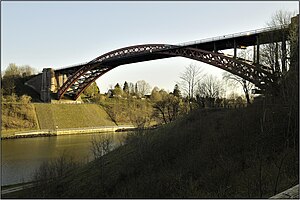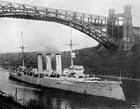Levensau High Bridge
Levensau High Bridge Levensauer Hochbrücke | |
|---|---|
 Levensau High Bridge | |
| Coordinates | 54°22′4″N10°4′33″E/ 54.36778°N 10.07583°E |
| Carries | Kiel-Flensburg Railway,local road |
| Crosses | Kiel Canal |
| Characteristics | |
| Design | Arch bridge |
| Material | Steel |
| Total length | 180 metres (590 ft) |
| Longest span | 163 metres (535 ft) |
| Piers in water | None |
| Clearance above | 42 metres (138 ft) |
| History | |
| Construction start | 1894 |
| Construction end | 1895 |
| Location | |
 | |
Levensau Motorway Bridge Levensauer Schnellstraßenbrücke | |
|---|---|
| Coordinates | 54°22′6″N10°4′38″E/ 54.36833°N 10.07722°E |
| Carries | Bundesstraße 76 |
| Crosses | Kiel Canal |
| History | |
| Construction end | 1984 |
| Location | |
 | |
TheLevensau High Bridge(German:Levensauer Straßen- und Eisenbahnhochbrücke;short:Levensauer Hochbrücke) is a high levelarch bridgethat spans theKiel Canalin theGermanstate ofSchleswig-Holstein.Built in 1894 it is the oldest bridge crossing theKiel Canal.A second bridge nearby, opened 1984, is referred to asLevensau Motorway Bridge(German:Levensauer Schnellstraßenbrücke).
Previous history
[edit]The lower section of the small riverLevensauwas extended between 1777 and 1784 to become part of theEider Canal.Between 1887 and 1895 the Eider Canal was further extended and straightened to become part of the Kiel Canal (thenKaiser-Wilhelm-Kanal). The extended canal necessitated afixed linkfor theKiel–Flensburg railwayas well as the principal road fromKieltoEckernförde.[1]
Historic pictures
Being a landmark on the Kiel canal, the bridge was depicted on postcards and also used as a popular background for pictures of ships transiting the canal.
-
The towers of the bridge, postcard from 1895
-
The bridge ca. 1900
-
Armoured cruiser
SMS Fürst Bismarck,1909 -
Light cruiser
SMS Dresden,ca. 1912 -
Battleship
SMS Schleswig-Holstein,1932
Design and construction
[edit]Construction of the bridge took 11⁄2years. Work on the abutments was started in June 1893 and bricklaying lasted until end of that year. On top of the abutments the bridge featured four towers by architectHermann Muthesius.The scaffolding that supported the steel elements during construction was erected from November 1893 and assembly of the steel construction started in May 1894. The bridge was inaugurated byEmperor Wilhelm IIin December 1894.[1] Originally the carriageway was designed in such a way that it could not be used by road and rail traffic simultaneously - if a train approached, the bridge was closed for cars and lorries. In the course of a first modification a barrier between road and railway was installed, however this limited the width of the road to 4.5 metres (15 ft) so that lorries were unable to pass each other on the bridge. Furthermore, the pedestrian way was only 90 centimetres (35 in) wide.[1] In 1954, the bridge was extensively reworked to allow for independent use by road, rail and pedestrians. The towers were torn down and the carriageway was enlarged.[1]
Replacement
[edit]In 1984 a four lane road bridge was opened for road traffic, taking over the role as main canal crossing for the Kiel–Schleswig road (route 76).
The current bridge is still used for the railway and local road traffic including bicycles. Its span is too short for the canal expansion to a width of 162 metres (531 ft). In 2009 the cost estimate for the replacement stood at 42 million Euros. The replacement of the old bridge with a substitute was decided in 2018. The replacement was also deemed necessary due to technical reasons. However, in addition to taking the geological condition of the subsoil into consideration the project also has to respect environmental aspects (for instance the presence of bats). The project itself with a number of illustrations and some information in English is presented by its engineers.[2] There is also a direct webcam displaying the bridge and the current construction zone.[3]
Bat habitat
[edit]Inside the old brick abutments a mixed colony of roughly 5,000 bats hibernate. The colony is protected under the Convention on International Trade in Endangered Species of Wild Fauna and Flora,CITES,and includesMicrobats,Common nocturles,Daubenton bats andNatterer bats.The population was examined by scientists of theKiel Universityand is considered the largest in Northern Europe.[4]
Gallery
[edit]Contemporary pictures
The Levensau Motorway Bridge, built in 1984, can be seen on some of the newer pictures
-
The bridge from the west, 2005
-
Detail of the bridge, 2011
-
View across the bridge, seen from the southern side
-
Old and new bridge in 2019
-
The old tower (southern side) will be maintained as bat habitat, despite the reconstruction (2019)
-
AContainer shipwith both bridges
-
Levensau Motorway Bridge and Levensau High Bridge
References
[edit]- ^abcd"Alte Levensauer Hochbrücke"[The old Levensau High Bridge].www.wsa-kiel.wsv.de(in German). Federal Water and Shipping Administration. Archived fromthe originalon 27 April 2012.Retrieved13 May2012.
- ^"Levensau High Bridge Reneval, Schleswig-Holstein".Retrieved2021-03-12.
- ^"Webcam displaying Levensau High Bridge".Retrieved2021-03-12.
- ^"Schutz von gefährdeten Arten"(in German).Retrieved2021-03-12.













